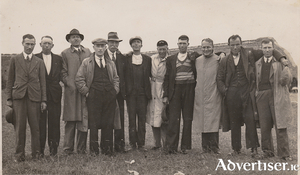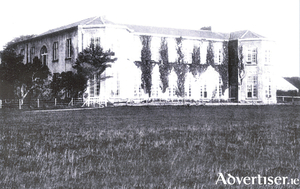Search Results for 'Galwegians library'
8 results found.
The homes of Woodquay

As we pointed out last week, much of what we now know as Woodquay was under water until the funnelling of the various streams that came down from the Corrib into the river that we know today began in the mid-19th century. As part of the project, the lands of Woodquay were gradually reclaimed. The people living in the area in those early years were mostly small farmers and fishermen. Their houses were very basic, single story, and for the most part, thatched and built of crude stone. There were of course some landmark houses but things began to change generally around the turn of that century with the construction of terraces of new slated houses around the broad space of Woodquay as we know it today, mostly built by the Urban District Council.
Market day in Woodquay

There were a number of aspects to the market in Woodquay in the 19th and early 20th centuries – there was a crane for weighing potatoes at the end of the park (near the toll booth) and it was there many of the farmers who carried their wares downriver used to gather to sell. Other groups would congregate here to sell scollops for thatching houses, ‘flexible sticks’ cut from hazel trees. These were very much in demand in the city area as so many houses were thatched in those days including in Woodquay. Also in that area you would find basket makers who would weave creels, ciseáins, skibs and baskets of many shapes and sizes for sale to the public.
Menlo oarsmen

One of the great sporting achievements of the last century was the remarkable success of a group of Irish speaking farmers and local men from Menlo. During a very wet spring when they could do little work on their farms or on the bog, as they watched rowing crews going up and down the river, a group of them decided to form a rowing club. They asked to become members of Menlo Emmetts Hurling Club and adopted the name. Many of them would have spent a lot of time on the river, but that did not mean they knew how to handle a racing boat. When they took their clinker out for the first time, it took them a good while to steady the boat. A local man watching, described them as “The Wobblers” and this name stuck for a few years.
Merlin Park House

The Blake family started work on the construction of Merlin Park House in 1808 and it was completed in 1812. It cost £12,000 to build and provided much needed employment for many local skilled workers and labourers. Getting materials to the location proved difficult – it was said that more than 40 mules were used to transport goods and building materials from Galway to the site.
Seapoint Corner about one hundred and fifty years ago

This was Seapoint Corner c1865. The buildings we see, running from the left, are Prospect Lodge; Corrig View; Elm View; Prairie House with the balcony, which was built 1855-1861 by Colman O’Donohoe who had obviously spent some time in America; Beachmount; Villa Marina, which had the sign Michael Horan, Grocer over the door; Sunnyside Lodge; Seapoint House; then a gap which led into Seapoint Terrace; and finally, the thatched building which was George Fallon’s Baths. The sign on his gable read Hot Baths and Bathing, No Refunds and his family operated the baths business at least from 1855 to 1894
Francis Corbett in his studio

Francis Corbett was a member of the well known business family who owned Corbett and Sons in Williamsgate Street. He was one of five siblings, one of whom, Gerard, went into the business. Francis also worked there but only for a short time, as he died relatively young in 1946. He was a talented artist, as were his brother Redmond and his sisters Lucy and Agnes. Francis was one of the founders of the Galway Art Club, and became its first treasurer.
Galway folklore
More than 300 primary school teachers attended a conference in Tuam in 1937, 80 years ago tomorrow, to launch the Schools Folklore Collection in Galway County. This was a scheme which invited senior primary pupils, under direction, to go to the oldest person in their community or their grandparents to collect folklore and folk life traditions relating to their own area. Caitríona Hastings has just published a book in which she has selected material from this project which was gathered by pupils of 14 schools in Galway and environs. They are Menlo NS, Castlegar NS, Carrowbrowne NS, Barna, Bushypark, Presentation Convent, Convent of Mercy NS, Claddagh NS (boys), Claddagh (girls), St Brendan’s NS, Claregalway (boys), Claregalway (girls), Oranmore (boys), and Oranmore Convent.
A prospect of Galway, 1685

This hand coloured prospect of Galway, looking northeast, was drawn in 1685 by Captain Thomas Phillips, surveyor-general of the fortifications in Ireland. It is especially important as it is the only quasi-objective pictorial record of Galway to survive from this period.

